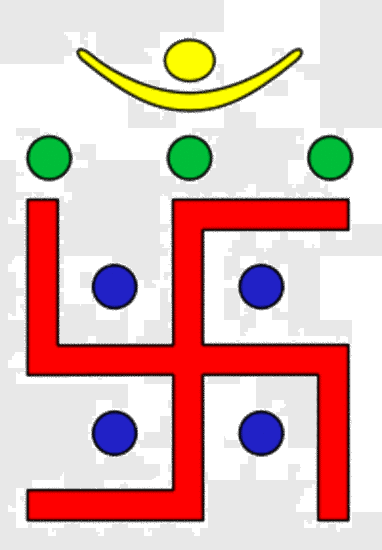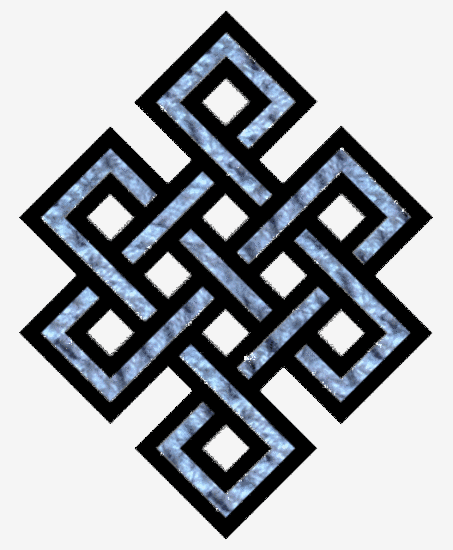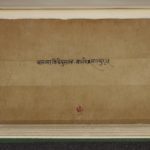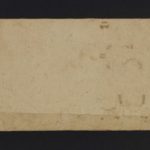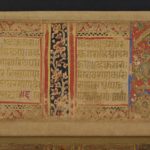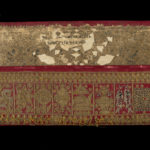Article: Eight auspicious symbols
The term ‘eight auspicious symbols’ refers to a set of eight shapes or objects highly respected by the Jains and which they use in various religious contexts. The word commonly used to refer to it is the Sanskrit compound aṣṭa-mangala. The word mangala designates anything that brings good luck or well-being in any way, whether an object or a phrase.
The two main Jain sects list slightly different objects as the eight auspicious symbols. For both groups, especially the Śvetāmbaras, these symbols appear in all kinds of artistic media and are widespread in temples, worship and in general life.
Different lists of the eight auspicious symbols

Svastikas and other auspicious symbols in the temple
Image by Cactusbones – Sue Ann Harkey © CC Attribution-NonCommercial-ShareAlike 2.0
As often happens, the list of the symbols is different for the two main Jain sects of the Śvetāmbaras and Digambaras.
|
1 |
Gilded vase – bhṛngāra |
|
|
2 |
Fly whisk – cāmara |
|
|
3 |
Banner – dhvaja |
|
|
4 |
Powder box or flask – vardhamānaka |
Fan – vyajana |
|
5 |
Throne – bhadrāsana |
Umbrella or canopy – chatra |
|
6 |
Full water-jug – kalaśa |
Seat of honour – supratiṣṭha |
|
7 |
Pair of fish – matsyayugma |
Full water-jug – kalaśa |
|
8 |
Mirror – darpaṇa |
Mirror – darpaṇa |
Why these objects?
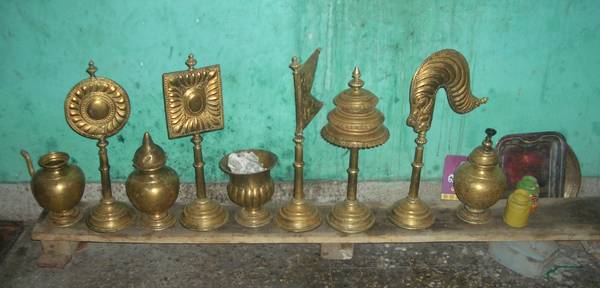
Auspicious symbols in a Digambara temple
Image by Nalini Balbir © Nalini Balbir
These things are auspicious for different reasons. The meaning of some of these symbols is apparent in wider Indian culture, while the significance of others is less clear.
Some of them – like the throne, the fly-whisk, the banner and the umbrella – are well known as royal insignia.
Others are connected to prosperity, abundance or fertility, for example the full jug or pitcher and the flask of powder. The word used for the latter means ‘increasing’.
The mirror may represent the idea of purity and light.
The meaning of the pair of fish is not that clear. A Śvetāmbara author from the 14th century, Vardhamāna-sūri, interpreted the auspicious symbols. He said that the fish may represent the god of Love, on whose banner they are shown, who has been defeated by the Jina and has come to worship him. Vardhamāna-sūri’s approach tried to connect the auspicious symbols with the Jinas and Jainism, although they can be seen as general signs of good luck in the Indian context.
First three Śvetāmbara symbols
The first three items in the Śvetāmbara list feature among the emblems of some of the Jinas among Śvetāmbaras and Digambaras.
|
Symbol |
Digambara Jina emblem |
Śvetāmbara Jina emblem |
|---|---|---|
|
Śītala – tenth Jina |
Supārśva – seventh Jina |
|
|
Supārśva – seventh Jina |
Ara – 18th Jina |
|
|
Śītala – tenth Jina |
Svastika
The svastika – known as the swastika in the West – is a cross with each of its four arms bent at a right angle and turned in a clockwise direction. The word itself connotes ‘good’ and ‘beneficial’. Svasti is a Sanskrit word meaning ‘well-being’. It is is often used as an exclamation, meaning, “May it be well!”
An ancient symbol found in civilisations dating back thousands of years, the svastika is often used to mark persons or things. It denotes good luck in Hinduism, Buddhism and Jainism. It is still widely used today in India, despite its sinister reputation, particularly in the West, after its close association with the Nazis.
In the Jain list of auspicious symbols, the svastika always comes first. The four arms of the svastika are considered to represent the four possible states of existence – gati – in the world of rebirth, namely:
- heavenly being or deity
- hell-being
- animal
- human being.
It is also interpreted as referring to the four parts of the Jain community – caturvidha-saṇgha, which are:
Nandyāvarta
The nandyāvarta is a shape like a labyrinth or a larger form of svastika. The term itself implies something positive, for nandī means ‘joy, prosperity’. This diagram has nine branches, which are said to symbolise the nine treasures of a universal monarch.
Śrīvatsa
Variations and general uses
The Śvetāmbara list is known from at least two Śvetāmbara canonical scriptures.
The Aupapātika-sūtra, the first Upānga, is the standard reference. When King Kūṇika heard that Mahāvīra, the first Jina, was about to preach, he left his palace in great pomp to reach the place of the universal gathering:
While he was mounted on his superb elephant here are the eight auspicious things that were present before him in the following sequence [which forms the standard list]
In the Jambū-dvīpa-prajñapti, the list has the same number of objects but some of the items are different. Here, the eight auspicious symbols of “Umbrella, banner, pot, fly whisk, mirror, seat, fan, and vessel proceeded before the Lord” (quoted in Jain-Fischer 1978: 11).
These two passages show that the auspicious signs present themselves in specific circumstances to persons of rank. These may be either conventional kings or Jinas, who are spiritual kings.
Early representations
The oldest depictions of the eight auspicious symbols are found on the votive tablets of Mathurā, dating back to the second to third centuries CE. The full jug, a pair of fish, the śrīvatsa, the svastika and the powder box can be recognised.
But there are also other symbols that do not belong to the classical lists, like the ‘three jewels‘ – tri-ratna. This indicates some variation before the lists took the standard form known today.
Symbols in the Jain temple
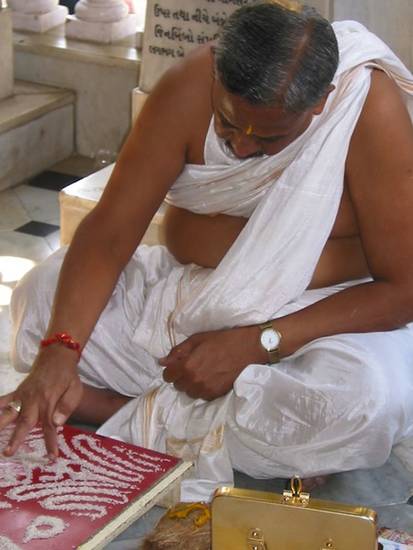
Creating auspicious symbols
Image by ૐ Didi ૐ – Dey © CC BY-NC-SA 2.0
The eight auspicious symbols are a central part of Jain religious life. They are a commonplace sight in many temples in the form of bas-reliefs or sculptures on temple walls. They can be seen most frequently on the door lintel or window frames of wooden domestic shrines.
In Digambara temples the eight auspicious symbols are often found as freestanding metal objects.
It is common to see Jain devotees sitting cross-legged in front of low wooden tables, producing elaborate pictures of some of the auspicious symbols with rice grains.
Creating svastikas and nandyāvartas is particularly widespread because both shapes are linked to the more general concepts of karma and rebirth. Sometimes the eight symbols are incised in the tables.
The worshippers place rice-grains over them and gently wipe them with the edge of the palm so that the grains fill the recesses to reveal the white design of the aṣṭamangala
Jain-Fischer page 11, 1978
The offering-stands, which are made of wood or metal, often have the eight auspicious symbols carved or set in relief. In the Tri-ṣaṣṭi-śalākāpuruṣa-caritra, the 12th-century writer Hemacandra describes how: ‘Below the arches were the eight auspicious signs, svastika, etc., just like those on offering-stands’. (Triṣaṣṭiśalākāpuruṣacaritra I.3.432, Johnson 1931: 190.)
Symbols in Śvetāmbara art and life
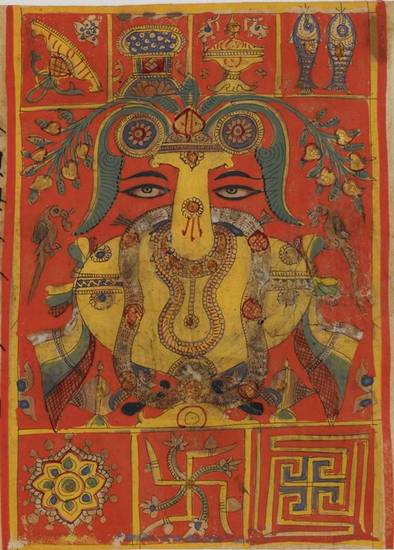
Eight auspicious symbols
Image by British Library © CC0 1.0 (Creative Commons Public Domain)
The Śvetāmbaras have developed the theme of the auspicious symbols into a religious and decorative motif.
The symbols appear both on the pages of manuscripts and on manuscript covers. They also feature in the invitation letters Jain communities in India send to leaders of mendicants, which invite them to spend the next rainy season with the laity. Śvetāmbara ascetics frequently have the symbols embroidered on the cloth they use to protect their monastic equipment.
Manuscript pages
A mangala in the form of words must appear at the start of a Jain text, whether it is a stanza or a sacred formula. Similarly, the eight auspicious symbols are a visual beginning. The symbols can be shown alone or in succession or may accompany the depiction of one of the religious teachers, especially Mahāvīra or his chief disciple, Indrabhūti Gautama.
Placing them at the opening of a text emphasises the connection of the auspicious symbols with passing on religious teachings.
Manuscript covers

Eight auspicious symbols
Image by Victoria and Albert Museum © V&A Images/Victoria and Albert Museum, London
Together with the 14 dreams, the eight auspicious symbols have proven one of the favourite Śvetāmbara themes on manuscript covers – called pāṭhuṃ in Gujarati – since the 18th century.
The Ethnographic Museum in Antwerp in Belgium – now part of the Museum Aan de Stroom (MAS) – has a good selection of such covers. They are made of either cardboard covered with cloth or painted wood. They demonstrate characteristics of the pictorial style of the regions where they were made.
Paintings in invitation scrolls
Invitation scrolls or vijñapti-patras are formal letters inviting a leading monk and his followers, from a certain monastic group, to spend the next rainy season in a certain place. A community of lay Jains sends these letters, the local merchants often sending these on behalf of the wider group.
These invitations take the form of long scrolls with text and paintings. The text consists of poetical description and praises of mendicants and the Jinas. Generally, the opening paintings are the eight auspicious symbols and the 14 auspicious dreams.
An example of an invitation scroll is in the Jain collection at the British Library.
These invitation letters are found in Rajasthan and Gujarat from the 17th century onwards. They are a speciality of the Śvetāmbara Kharatara-gaccha and Tapā-gaccha communities.
Embroideries of the symbols

Monastic bookstand with embroidered svastikas
Image by Nalini Balbir © Nalini Balbir
Śvetāmbara monks and nuns wrap the handle of their brooms or small book-stand – sthāpanācārya – in pieces of cotton or woollen cloth. One or all of the auspicious symbols are often embroidered on them.
Reading
- Jaina Temple Architecture in India: The Development of a Distinct Language in Space and Ritual
Julia A. B. Hegewald - Monographien zur Indischen Archäologie, Kunst und Philologie series; volume 19
Stiftung Ernst Waldschmidt, G+H Verlag; Berlin, Germany; 2009
- 'The Kalpa Sûtra of Bhadrabâhu'
Bhadrabāhu - translated and edited by Hermann Jacobi
Abhandlungen für die Kunde des Morgenlandes
Deutschen Morgenländischen Gesellschaft series; series editor Otto Loth; volume VII: 1
F. A. Brockhaus; Leipzig, Saxony, Germany; 1879
- A Descriptive and Illustrated Catalogue of Miniature Paintings of the Jaina Kalpasūtra as executed in the Early Western Indian Style
W. Norman Brown - Freer Gallery of Art – Oriental Studies series; volume 2
The Lord Baltimore Press / Smithsonian Institution; Washington DC, USA; 1934
- Studies in Jaina Art
Umakant Premanand Shah - Abhinav Publications; Banaras, Uttar Pradesh, India; 1955
- Treasures of Jaina Bhandāras
Umakant Premanand Shah - L. D. series; volume 69
L. D. Institute of Indology; Ahmedabad, Gujarat, India; 1978
- Steps to Liberation: 2500 Years of Jain Art and Religion
Jan van Alphen - Etnografisch Museum Antwerpen; Antwerp, Belgium; 2000
- Historical Dictionary of Jainism
Kristi L. Wiley - Historical Dictionaries of Religions, Philosophies, and Movements series; series editor Jon Woronoff; volume 53
Scarecrow Press; Maryland, USA; 2004
Links
- Temple decorated for Dīvālī
-
Jains commemorate the final liberation of the 24th Jina, Mahāvīra, in the festival of Dīvālī in late September or October. At Dīvālī, as in other festivals, statues and temples are lavishly decorated, as shown in this 2007 Flickr photograph of the Katraj temple in Pune, Maharashtra. Lights are festooned everywhere during the 'Festival of Lights', with both electric lighting and traditional clay lamps – dīpas – used. Examples of the ancient auspicious symbol of the svastika, with four dots representing the Jain community or the four states of existence, are clearly seen either side of the temple entrance.
http://www.flickr.com/photos/darvekar/1978597664/in/set-72157603105954957/
- Group initiation of Digambara monks – part 2
-
As part of their group ceremony of renunciation – dīkṣā – novice monks have the last tufts of hair plucked out by their teacher Vidyāsāgar. Then they remove their clothes amid the rejoicing of the large crowd of lay Jains. As a sign of detachment from worldly affairs, public nudity is associated with advanced spirituality and is the mark of a fully-fledged monk in Digambara Jainism. Then Vidyāsāgar traces the auspicious symbols of svastikas and four dots on their heads in sandalwood paste. Found on YouTube, this collective ceremony in Hindi took place on 21 August 2004 in the so-called Dayoday Tirth, Delwara Ghat, in the town of Jabalpur in Madhya Pradesh on the bank of the river Narmada. Watch the next part of the ceremony at: http://www.youtube.com/watch?v=K0WeUJici30&NR=1
- Group initiation of Digambara monks – part 3
-
Towards the end of their group ceremony of renunciation – dīkṣā – 25 new Digambara monks have their heads anointed with sandalwood paste. The monk Vidyāsāgar, who is initiating them, traces the auspicious symbols of swastikas and four dots on their heads and palms. Then he blesses the new monks and newly initated novices – kṣullaka – who are dressed in white. He also consecrates their water pots – kamaṇḍalu. Both groups of mendicants hold their characteristic peacock-feather brooms – piñchī. Found on YouTube, this collective ceremony in Hindi took place on 21 August 2004 in the so-called Dayoday Tirth, Delwara Ghat, in the town of Jabalpur in Madhya Pradesh on the bank of the river Narmada. Watch the final part at http://www.youtube.com/watch?v=6QCfjoyWbLk
- Svastika during Paryuṣaṇ
-
A svastika formed out of traditional clay lamps – dīpas in Sanskrit – is arranged on the petal-strewn floor of a temple during the festival of Paryuṣaṇ. The svastika is an ancient symbol of good luck and is frequently found in Jain temples, on religious equipment and on books, clothing and so on. The four dots among the arms of the svastika represent either the four states of existence or the parts of the fourfold community. Lasting eight days in late August or early September, Paryuṣaṇ is the most important Śvetāmbara Jain festival. This photograph on Flickr was taken in 2007.
- Introduction to Jainism – part 2
-
This extract from a BBC documentary called The Frontiers of Peace explores the relationship between Jain traditions and modernity. A Jain lay man tells how he reconciles his faith with his industrial business interests. A Śvetāmbara monk explains the significance of his monastic broom – known as a rajoharaṇa or oghā – including the eight auspicious symbols wrapped around the handle. A nun leads lay followers in the rite of confession – pratikramaṇa. A young woman creates auspicious symbols in rice as an offering as she talks about her decision to become a nun. This 2010 YouTube video is the second of four parts. See the next part at: www.youtube.com/watch
- Introduction to Jainism – part 3
-
This extract from a BBC documentary on Jainism called The Frontiers of Peace explores the concept of renunciation. The video follows a young woman's decision to become a nun and a rich lay man's faith. The ritual of keśa-loca is filmed, in which monks and nuns pull out their hair. The lay man is shown making the auspicious symbols of the svastika, three dots representing the 'three jewels' of right insight, right knowledge and right conduct and the horizontal crescent of the siddha-śilā, where liberated souls live. This 2010 YouTube video is the third of four parts. See the next part at: http://www.youtube.com/watch?v=670KFhISeUk
- Explanations of Jain symbols
-
The website Namoka Tirth provides explanations for the common Jain symbols. Unexpectedly, this Digambara organisation offers the Śvetāmbara list of eight auspicious symbols.
Note that some of the website's assertions are not accepted by professional scholars because there is no indisputable historical proof. An example here is the dating of the first Jina, Ṛṣabha.
As with many Jain websites, the use of diacritics and transliterations here is inconsistent and does not meet academic standards.
- Eight auspicious symbols
-
Pictures and brief explanations of the eight auspicious symbols according to the Svetāmbara sect are provided by the HereNow4U website. The explanations of some of the items are not necessarily the same as those given in JAINpedia and other sources.
- Eight auspicious symbols
-
Pictures and brief explanations of the eight auspicious symbols according to the Svetāmbara sect are provided by the HereNow4U website. The explanations of some of the items are not necessarily the same as those given in JAINpedia and other sources.
- +
- aAbhavya
- aAbhinandana
- aAbhiṣeka
- aĀcāra
- aĀcārāṅga-sūtra
- aĀcārya
- aAchalbhrata
- aAḍhāī-dvīpa
- aAdharma
- aAdho-loka
- aAdhyayana
- aAdvaita Vedānta
- aĀgama
- aAghātīya
- aAghātīya-karman
- aAgnibhuti
- aAgra
- aĀhāra
- aAhiṃsā
- aAhimsa Day
- aAjita
- aAjīva
- aAkampit
- aĀkāśa
- aAkbar the Great
- aAkṣaya-tṛtīyā
- aAlauddin Khalji
- aAlbert Einstein
- aAllah
- aAlms
- aĀlocanā
- aAloka-ākāśa
- aAmāri
- aAmbikā or Kūṣmāṇḍinī
- aAnagāra
- aAnanta
- aAnarthadaṇḍa
- aAnaśana
- aAnekānta-vāda
- aAṅga
- aAniconism
- aAnojjā
- aAntarāla
- aAntarāya-karma
- aAṇu
- aAṇu-vrata
- aAnukampā
- aAnuprekṣā
- aAnusvāra
- aApabhraṃśa
- aAparigraha
- aAra
- aĀrambha
- aĀrambhaja
- aĀratī
- aArdhamāgadhī Prākrit
- aArhaṃ
- aArhat
- aArśana-āvaraṇīya-karma
- aĀrta-dhyāna
- aĀryikā
- aĀryikā Jñānamati
- aĀśātanā
- aĀścarya
- aAscetic
- aAsceticism
- aAshram
- aAspiration
- aĀsrava
- aAṣṭa-maṅgala
- aAṣṭāpada
- aAstikāya
- aAstrolabe
- aAsura
- aAtheism
- aAticāra
- aAtiśayakṣetra
- aAtithisaṃvibhāgavrata
- aĀtma-vāda
- aĀtman
- aAuṃ
- aAurangzeb
- aAuspicious
- aAusterity
- aAvadhāna
- aAvadhi-jñāna
- aĀvaraṇī-yakarman
- aAvasarpiṇī
- aAvatāra
- aAvidyā
- aAxiom
- aĀyāga-paṭa
- aĀyambil
- aĀyu-karma
- aĀyurveda
- bBabur
- bBāhubali
- bBaladeva
- bBālāvabodha
- bBandha
- bBasadi
- bBazaar
- bBhadrankarvijay
- bBhagavant
- bBhaktāmara-stotra
- bBhakti
- bBhale
- bBharata
- bBhāṣā
- bBhāṣya
- bBhaṭṭāraka
- bBhāva
- bBhāva-pūjā
- bBhāvanā
- bBhavana-vāsin
- bBhavya
- bBhavyatva
- bBhaya
- bBhoga-bhūmi
- bBhogopabhoga
- bBodhi
- bBollywood
- bBrahmā
- bBrahma-deva
- bBrahmacārī
- bBrāhmaṇa
- bBraj Bhāṣā
- bBright fortnight
- bBritish Raj
- bBuddha
- bBuddhi-sagar
- bBuddhism
- bBuddhist
- cCaitya
- cCaityavāsin
- cCakravartin
- cCakreśvarī
- cCāmara
- cCandanā
- cCandragupta
- cCandraprabha
- cCanon
- cCāritra
- cCāritramohanīya-karman
- cCarũrī
- cCaste
- cCaturvidha-saṅgha
- cCaturviṃśati-stava
- cCāturyāma
- cCE
- cCelibacy
- cCha
- cChadmastha
- cChastity
- cCheda-sūtra
- cChristian
- cChristianity
- cClergy
- cCloning
- cColophon
- cCommentary
- cConch
- cConfession
- cCongregation
- cConsecration
- cCosmology
- cCremation
- cCrore
- cCult
- cCūrṇi
- dDādā-guru
- dDalit
- dDāna
- dDaṇḍa
- dDark fortnight
- dDarśana
- dDarśanamohanī-yakarman
- dDaśa-lakṣaṇa-parvan
- dDeity
- dDelhi Sultanate
- dDerāsar
- dDeśāvakāśika-vrata
- dDetachment
- dDevanāgarī
- dDevānandā
- dDevarddhi-gani
- dDevotee
- dDhamal
- dDhanuṣ
- dDhāra
- dDharma
- dDharma-dhyāna
- dDharma-sāgara
- dDharmastikaya
- dDhātakīkhaṇḍa
- dDholak
- dDhyāna
- dDiaspora
- dDig-vrata
- dDigambara
- dDīkṣā
- dDisciple
- dDīvālī
- dDivya-dhvani
- dDNA
- dDoctrine
- dDogma
- dDonor
- dDoṣa
- dDravya
- dDravya-pūjā
- dDrone
- dDuṣamā
- dDuṣamā-duṣamā
- dDuṣamā-suṣamā
- dDveṣa
- dDvīpa
- eEast India Company
- eEightfold Path
- eEkānta-vāda
- eEkendriya
- eElder
- eElders
- eEschatology
- eEtc up to
- fFarmān
- fFast
- fFatehpur Sikri
- fFestival
- fFestschrift
- fFiruz Shah
- fFly-Whisks
- fFolio
- fFour Noble Truths
- gGaccha
- gGaṇa
- gGaṇadhara
- gGanadharavada
- gGaṇeśa
- gGaṇin
- gGarba
- gGarbha
- gGarbha-gṛha
- gGaruḍa
- gGati
- gGene
- gGenomics
- gGhātī-yakarman
- gGhātīya
- gGhaznavid
- gGhiyasuddin Tughlaq
- gGhurid
- gGloss
- gGotra-karma
- gGujarāt
- gGujarati
- gGuṇa
- gGuṇa-sthāna
- gGuṇa-vrata
- gGupti
- gGuru
- gGuruṇī
- hHagiography
- hHajj
- hHaṃsa
- hHaribhadra
- hHariṇaigameṣin
- hHasta
- hHeresy
- hHiṃsā
- hHindi
- hHindu
- hHinduism
- hHīravijaya
- hHoroscope
- hHrīṃ
- hHumayun
- hHymn
- iIconoclasm
- iIconography
- iIdol
- iIndian Independence
- iIndology
- iIndra
- iIndrabhūti Gautama
- iIndriya
- iInitiation
- iIntercession
- iInvocation
- iIQ
- iIslam
- iIslamicate
- iIṣṭadevatā
- iĪśvara
- jJagat
- jJahangir
- jJain
- jJaina Devanāgarī
- jJaina Śaurasenī
- jJaina-dharma
- jJainaśāsana
- jJainness
- jJaisalmer
- jJamāli
- jJambū-dvīpa
- jJames Burgess
- jJanma
- jJanma-kalyāṇa
- jJarā
- jJāti
- jJina
- jJina-āgama
- jJina-bhavana
- jJina-bimba
- jJina-mātā
- jJinacandra-sūri
- jJinadatta
- jJinaprabha
- jJīva
- jJñāna
- jJñāna-āvaraṇīya-karma
- jJñāna-āvarṇiya
- jJñānsundar
- jJyotiṣka
- kKāla
- kKālakācārya-kathā
- kKālidāsa
- kKalpa-sūtra
- kKalpa-vṛkṣa
- kKalyāṇaka
- kKalyanvijay
- kKamaṇḍalu
- kKamaṭha
- kKarma
- kKarma-bhūmi
- kKarma-grantha
- kKarma-prakṛti
- kKarma-vāda
- kKarmon
- kKarnataka
- kKaṣāya
- kKathā
- kKāvya
- kKāya
- kKāyotsarga
- kKeśa-loca
- kKetu
- kKevala-jñāna
- kKevalin
- kKhalji
- kKharatara-gaccha
- kKnowledge
- kKriyā
- kKriyā-vāda
- kKṛṣṇa
- kKṣamā-śramaṇa
- kKṣapakaśreṇi
- kKṣatriya
- kKṣullaka
- kKulakara
- kKundakunda
- kKunthu
- lLabdhi
- lLaity
- lLakh
- lLāñchana
- lLands of Action
- lLaukāntika
- lLavaṇa-samudra
- lLeśyā
- lLiṅga
- lLinguistics
- lLoka
- lLoka-ākāśa
- lLoka-puruṣa
- lLoka-vāda
- lLotus
- lLotus lake
- mMadhya-loka
- mMahā-videha
- mMahā-vrata
- mMahābhārata
- mMahāmastakābhiṣeka
- mMāhārāṣṭra
- mMāhārāṣṭrī Prākrit
- mMahattarā Yākinī
- mMahāvīr Jayantī
- mMahāvīra
- mMakāra
- mMakkhali Gośāla
- mMalli
- mMāna-stambha
- mManaḥ-paryāya-jñāna
- mMaṇḍala
- mMaṇḍapa
- mMandit
- mMaṅgala
- mMantra
- mMantras
- mManuṣya-loka
- mMarāṭhī
- mMārgaṇā
- mMartyr
- mMarudevī
- mMaṭha
- mMati-jñāna
- mMauryaputra
- mMecca
- mMendicant lineage
- mMetarya
- mMiracle
- mMithyādṛṣṭi
- mMohandas Gandhi
- mMohanīya-karma
- mMokṣa
- mMonastic order
- mMonasticism
- mMonk
- mMonotheism
- mMosque
- mMount Meru
- mMount Sammeta
- mMṛgāvatī
- mMughal
- mMuhammad
- mMuhammad bin Tughlaq
- mMuhpattī
- mMūla-sūtra
- mMūlaguṇa
- mMumbaī
- mMuni
- mMunisuvrata
- mMurad Bakhsh
- mMūrti-pūjaka
- mMuslim
- mMysticism
- nNābhi
- nNāga-kal
- nNāgapurīya Tapā-gaccha
- nNāgarī
- nNāma-karma
- nNamaskāra-mantra
- nNami
- nNandīśvara-dvīpa
- nNandivardhana
- nNandyāvarta
- nNāraka
- nNāraki
- nNasalisation
- nNātha
- nNavrātrī
- nNaya-vāda
- nNemi
- nNidāna
- nniggaṃthāṇa vā 2
- nniggaṃtho vā 2
- nNigoda
- nNihnava
- nNikṣepa
- nNirgrantha
- nNirjarā
- nNirvāṇa
- nNiryukti
- nNiṣidhi
- nNitya
- nNiyati
- nNo-kaṣāya
- nNudity
- nNun
- oOcean of milk
- oOmniscience
- oOrdination
- ppa°
- pPadmaprabha
- pPadmāsana
- pPadmāvatī
- pPādukā
- pPalanquin
- pPalette
- pPañca-muṣṭi
- pPāṇḍava
- pPaṇḍit
- pPandit Dalsukh D. Malvania
- pPandit Sukhlalji
- pPāṇipātra
- pPāpa
- pParamātman
- pParameṣṭhin
- pPāraṇā
- pParigraha
- pPariṇāma
- pParīṣaha
- pParokṣa
- pPārśva
- pPārśvanātha
- pParyāya
- pParyuṣaṇ
- pPaṭa
- pPatan
- pPātra
- pPenance
- pPersian
- pPhala
- pPhilology
- pPicchikā
- pPilgrimage
- pPīr
- pPolymath
- pPoṣadha
- pPossession
- pPothī
- pPrabhas
- pPradakṣiṇā
- pPradeśa
- pPrākāra
- pPrakīrṇaka-sūtra
- pPrākrit
- pPramāda
- pPramukhā
- pPrati-vāsudeva
- pPratikramaṇa
- pPratimā
- pPratiṣṭhā
- pPratyākhyāna
- pPratyakṣa
- pPravacana
- pPrāyaścitta
- pPrayer
- pPre-modern
- pPreach
- pPredestination
- pProtestant
- pProvenance
- pPudgala
- pPūjā
- pPujārī
- pPukharavara-dvīpa
- pPuṇya
- pPūrva
- pPuṣkara-dvīpa
- pPuṣpadanta
- pPyre
- qQur’an
- rRāga
- rRāhu
- rRainy season
- rRajasthan
- rRajasthani
- rRājimatī
- rRajoharaṇa
- rRajput
- rRāma
- rRāmāyaṇa
- rRangoli
- rRās-garbā
- rRasa
- rRathanemi
- rRatna-traya
- rRātri-bhojana
- rRaudra-dhyāna
- rRecto
- rRelic
- rRenunciation
- rRetroflex
- rRevatī
- %Ṛg-veda
- rRite
- rRosary
- %Ṛṣabha
- %Ṛṣabhanātha
- rRupee
- sSaciyā Mātā
- sSādhu
- sSādhvī
- sSāgāra
- sSaint
- sŚaivaism
- sŚaka-saṃvat
- sSallekhanā
- sŚalya
- sSamacatuṣṭha
- sSamādhimaraṇa
- sSamaṇi
- sSāmarambha
- sSamavasaraṇa
- sSāmāyika
- sSaṃbhava
- sSamiti
- sSaṃjñā
- sSaṃkalpaja
- sSaṃsāra
- sSamudghāta
- sSaṃvara
- sSaṃvega
- sSamyak-cāritra
- sSamyak-darśana
- sSamyak-jñāna
- sSamyaktva
- sSaṃyama
- sSanctuary
- sSandalwood
- sSaṇgha
- sSanskrit
- sSant
- sŚānti
- sSapta-bhaṅgi-naya
- sSārambha
- sSarasvatī
- sSarvajña
- sSāsan-devi
- sŚāsana-devatā
- sŚāstra
- %Ṣaṭ-jīvanikāya
- sSatī
- sSatīmātā
- sSatya
- sSchism
- sScribe
- sScripture
- sSect
- sSecularism
- sŚenāī
- sSermon
- sŚeṣavatī
- sSevā
- sSeven fields of donation
- sShah Jahan
- sShantidas Jhaveri
- sShrine
- sSiddha
- sSiddha-śilā
- sSiddhacakra or Navadevatā
- sSiddhānta
- sSiddhārtha
- sSiddhi
- sSikh
- sSikhism
- sŚikṣā-vrata
- sŚīla
- sSin
- sSindh
- sŚītala
- sŚiva
- sSkandha
- sSomanatha
- sŚraddhā
- sŚramaṇa
- sŚrāvaka
- sŚrāvakācāra
- sŚrāvikā
- sŚreyāṃsa
- sŚrī
- sŚrīvatsa
- sŚruta-jñāna
- sŚruta-pañcamī
- sSthānaka-vāsin
- sSthāpanācārya
- sSthāvara
- sSthavira
- sSthiti
- sStrīmukti
- sStūpa
- sSubcontinent
- sSudarshana
- sŚuddhi
- sSudharma
- sŚūdra
- sSufism
- sSukha
- sŚukla-dhyāna
- sSulasā
- sSultan
- sSumati
- sSundarśrī
- sSupārśva
- sSūri
- sSuṣamā
- sSuṣamā-duṣamā
- sSuṣamā-suṣamā
- sSūtra
- sSuyam me ausam! Tenam bhagavaya evamakkhayam
- sSvādhyāya
- sSvāhā
- sSvastika
- sŚvetāmbara
- sŚvetāmbara Terāpanthin
- sŚvetāmbaras
- sSwan
- sSyād-vāda
- tTabla
- tTantra
- tTapā-gaccha
- tTapas
- tTāraṇ Svāmī Panth
- tTattva
- tTattvārtha-sūtra
- tTemple
- tTemple-city
- tThe Enlightenment
- tTheology
- tThree worlds
- %Ṭīkā
- tTilaka
- tTīrtha
- tTīrthaṃkaranāma-karman
- tTīrthankara
- tTransliteration
- tTrasa
- tTrasa-nāḍī
- tTriśalā
- tTriṣaṣṭi-śalākā-puruṣa-caritra
- tTti bemi
- tTughlaq
- tTunk
- uUdumbara
- uUniversal History
- uUpādhyāya
- uUpāṅga
- uUpaniṣads
- uUpāsaka
- uUpasarga
- uUpāśraya
- uŪrdhva-loka
- uUtsarpiṇī
- uUttarādhyayana-sūtra
- vVāhana
- vVaimānika
- vVairāgya
- vVaiṣṇava
- vVaiśramaṇa
- vVaiśya
- vValabhī
- vVanaspatikāya
- vVandana
- vVaṇik
- vVarṇa
- vVāsudeva
- vVāsupūjya
- vVayubhūti
- vVeda
- vVedanīya-karma
- vVegetarianism
- vVehicle
- vVernacular
- vVerso
- vVidyā
- vVidyā-devī
- vVihāra
- vVijñapti-patra
- vVikrama-saṃvat
- vVikṛti
- vVimala
- vVinaya
- vVipāka
- vVirji Vora
- vVirodhaja
- vVīrya
- vVisarga
- vViṣṇu
- vVītarāga
- vVizier
- vVotive
- vVow
- vVrata
- vVS
- vVyakta
- vVyantara
- vVyasana
- yYakṣa
- yYakṣī
- yYantra
- yYaśoda
- yYaśovijaya
- yYati
- yYātrā
- yYoga
- yYoginī
- yYojana


